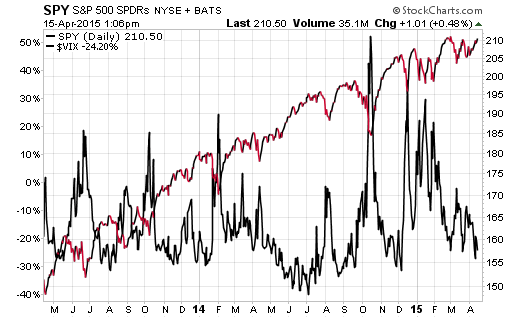Risk management has become a buzz word in the investment business with little real world application over the last several years. The need for stop losses, hedging, strategic asset allocation, and other counter-measures to traditional market cycles has been overridden by a “buy the dip” mentality. Active investors have been conditioned to wait for a little speed bump and then race into the fray with extra cash to buy up stocks and ETFs.
It’s no wonder that this strategy has worked so well considering the big moves in volatility futures along with other greed/fear indexes. A 2-year look back at the CBOE Volatility Index (VIX) versus the SPDR S&P 500 ETF (ARCA:SPY) shows just how quickly investors go from bullish to bearish.

Every rally is met with skepticism, while every dip is quickly hedged with options, cash, or a flight to quality. This happens within a matter of days or weeks and the ship always seems to right itself in a very swift manner.
Risk managers have been punished under this regime as recency bias overrides the best intentions of those that remember how quickly things can change. 2008 seems like it was barely more than a dream, as we plow to new all-time highs on a regular basis and celebrate the confidence that the Federal Reserve has bestowed upon us.
As a trend follower and sensible money manager, I have been participating in the strength of both stocks and bonds through a variety of low-cost ETFs. Nevertheless, I understand that one day the music is going to stop without notice and everyone will have to find a chair, lest they risk falling solidly to the floor.
Trends can often last far beyond reasonable expectations, which is why I never try to call market tops and bottoms. I would much rather err on the side of caution (in both directions) by focusing on the price patterns relative to long-term moving averages. That way I am able to participate in the upside with the knowledge that I will have to one day step aside to avoid big losses.
During this period of relative stability and good will in the markets, I believe it’s prudent to refresh your risk management plan along with establishing sound trading principles in your portfolio. That way you aren’t caught off guard and making decisions under pressure when cycles change – and believe me, they will change one day.
The following are some thoughts on managing risk in your portfolio:
- Never fall in love with any investment. One of things I love about ETFs is that they are faceless investments that are simply tools to be used in your wealth compounding efforts. They don’t have a charismatic CEO or market-leading product that may impede your decision-making process. Fall in love with your kids, your spouse, your dog, but not your stocks or bonds.
- Review your stock mix in the context of your risk tolerance. If you find yourself going into earnings season sweating every announcement for each stock in your portfolio, then you are leaning too heavy on the gas. Take a step back and evaluate your holdings – if you are wary about your biotech or solar stock gains, you may want to switch to a lower volatility position such as the iShares MSCI USA Minimum Volatility ETF (NYSE:USMV). I own this fund in my own account to provide correlation with the market with less downside risk than a fully loaded index.
- Review your portfolio’s sensitivity to interest rates. Stocks aren’t the only thing you have to worry about on the downside. The impact of interest rates and/or credit sensitivity within your bond holdings should be another key consideration as we may be entering the late stages of the current rate cycle. Interest rate sensitive asset classes like REITs, preferred stocks, and utilities should also be evaluated in the context of their advantages and risks. As long as they are adding value, continue to hold them with the understanding that you may need to make shifts along the way to shorten duration or seek out new pockets of strength.
- Consider implementing stop losses to define your downside risk. One simple way to ensure you never experience a significant decline in your investments is to implement trailing stop losses. This might be a specific percentage or dollar amount from the most recent high and will follow the price higher as it moves up. The advantage is that you define the capital at risk to the downside with a floor that will move you to cash. There is always a tradeoff of being whipsawed should the market immediately bounce back after you have sold. However, it’s a compromise that many disciplined investors are willing to make to avoid a big loss.
- Use cash as a short-term save haven. Cash can be an effective tool to reduce the volatility of your portfolio on a short-term basis. It also allows you to scan the investment landscape with a clear mindset and deploy capital in new opportunities. Nevertheless, many investors fall into the unintentional trap of holding too much cash for too long. This typically leads to further indecision and can impair the performance returns needed to reach your goals. Use cash as a vacation spot, rather than as your full-time homestead.
No matter what your methodology for the market may be, doing some of this analysis may help shed light on weak spots in your portfolio.As always, having a disciplined approach and implementing it decisively will produce superior investment results.
Disclosure: FMD Capital Management, its executives, and/or its clients may hold positions in the ETFs, mutual funds or any investment asset mentioned in this article. The commentary does not constitute individualized investment advice. The opinions offered herein are not personalized recommendations to buy, sell or hold securities.
